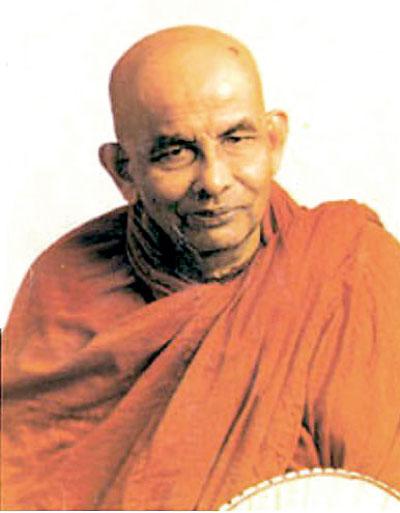09 Sep 2023 - {{hitsCtrl.values.hits}}
 Although 20 years have elapsed since the demise of the Most Venerable Madihe Paňňāsīha Mahānāyaka Thera, he still resonates in the minds of Sri Lankan society.
Although 20 years have elapsed since the demise of the Most Venerable Madihe Paňňāsīha Mahānāyaka Thera, he still resonates in the minds of Sri Lankan society.
This is because of the indelible mark the Venerable monk has etched in the annals of this country. Many a time he is referred to as the uncrowned Sangharaja because of the deep respect with which he was regarded not only by all members of the Maha Sangha but also by the religious community at large.
He had earned this respect as he never infringed the code of conduct of a monk, his forthright statements, fearlessness and prudence. His contributions to the betterment of society, in general, and the upliftment of the Buddha Sasana, in particular, made him an outstanding leader and a stalwart of the 20th century.
Born on June 21, 1913, his parents were an Anglican father and a very devout Buddhist mother. They were residents of Madiha in Matara and had his secondary education at St. Thomas College, Matara.
 He became a novice monk at the age of 13 years under the tutelage of Venerable Weragampitiye Sri Revatha Mahā Thera. He was still a novice when he came to Vajiraramaya, Bambalapitiya to be mentored by Most Venerable Pelene Vajiraňāṇa Maha Thera, a senior pupil of Venerable Weragampitiye Sri Revatha Mahā Thera.
He became a novice monk at the age of 13 years under the tutelage of Venerable Weragampitiye Sri Revatha Mahā Thera. He was still a novice when he came to Vajiraramaya, Bambalapitiya to be mentored by Most Venerable Pelene Vajiraňāṇa Maha Thera, a senior pupil of Venerable Weragampitiye Sri Revatha Mahā Thera.
At Vajiraramaya he had the opportunity to closely associate and interact with other resident monks, such as Venerable Narada, Venerable Piyadassi, and Venerable Ampitiye Rahula to name only a few.
He continued his bhikkhu education under Most Venerable Pelene Vajiraňāṇa Maha Thera and thereby benefitted from the use of the Siri Vajiraramaya library which had one of the best collections of books in the oriental languages at the time.
The letter of recommendation given by Most Venerable Pelene Vajiraňāṇa Maha Thera regarding his knowledge and competence was sufficient for him to follow the Vidyā Viśāradha degree course started by Professor G. P. Malalasekera at the University College in Colombo.
His close association with Most Venerable Pelene Vajiraňāṇa Maha Thera, along with the deep influence his mother and the patriotic monk Bhikkhu Mahinda of Sikkim had during his formative age, was instrumental in determining his future mission in life.
In many of the early writings of Venerable Maḍihe Paňňāsīha Maha Thera, there is often reference to Sri Lanka being a Dharmadvīpa, an Isle of Righteousness, and a Peradiga Dhānyāgāraya, a Granary of the East.
In fact, that was the vision he had, namely, to make Sri Lanka, once again, a Dharmadvīpa and a Dhānyāgāraya. From about 1955, when his beloved teacher Most Venerable Pelene Vajiraňāṇa Maha Thera passed away, until his death on September 07, 2003, he worked relentlessly and indefatigably towards achieving this goal. Many are the projects and programmes he initiated where I had the good fortune to work with him closely from about 1960.
His contribution to fostering the development of the Buddha Sasana by establishing ab novo the Bhikkhu Training Centre at Maharagama along with Venerable Ampitiye Sri Rahula Maha Thera is unique. The aim was to bring forth well-disciplined bhikkhus with the six qualities mentioned by the Buddha that will illumine the Sasana, to wit, ‘being accomplished, disciplined, skilled, learned, knowers of the Dhamma and trained in conformity to the Dhamma’.
This task was adequately fulfilled and the products of the Bhikkhu Training Centre, which was renamed Siri Vajiraňāṇa Dharmāyatanaya in honour of their renowned teacher, are illumining the Buddha Sasana both in Sri Lanka and abroad.
Venerable Maḍihe Paňňāsīha Mahā Thera had exceptional qualities. When he stood up, literally, he was above all others because of his stature and calm demeanour. Hence, it was not by chance that he was unanimously selected to succeed Most Venerable Pelene Vajiraňāṇa Maha Thera as the Chief Prelate of the Nikaya he belonged to overlooking many senior monks.
He was only 42 years of age and was the youngest of the Mahānāyaka Theras. The new title did not adorn him but he adorned the title that was given. There were 27 sub-sects of the Amarapura Nikāya and by his tireless efforts, he succeeded in holding a united upasampadā ceremony at the consecrated boundary or sīmā at the Maharagama Dharmāyatanaya.
This was the beginning of the current Sri Lanka Amarapura Mahā Nikāya. A position of Highest Mahānāyaka or Uttarītara Mahānāyaka was created in unison with all the Mahānāyaka Theras of the 27 sub-sects and Venerable Maḍihe Mahānāyaka Thera was honoured to hold this highest position uncontested.
In 1988, as a brainchild of the Mahānāyaka Thera, a monastic conference was held with the patronage and the presence of the Most Venerable Mahānāyaka Theras of the Siyāmopali and Rāmaňňa Mahā Nikāyas. Nine papers were presented at this conference, of which five were for the progress of the Buddha Sasana and four for the progress of Sri Lankan society in general.
The five papers about Buddha Sasana were on 1) Samma Sambuddha Sāsanaya; 2) Bhikkhuni Order; 3) Bhikkhu Education; 4) Dharmadūta work abroad; and 5) Bill to regulate establishing places of worship.
The four papers for lay society were on 1) Lay Education; 2) Religious education in schools; 3) Use of alcohol, tobacco and drugs, and gambling; and 4) National Unity and Governance.
All-in-all, there were 63 recommendations under the respective headings and were presented to the Government and the general public. The last recommendation was to establish a Progress Monitoring Committee.
This was the genesis of the Buddha Sāsana Kāryasādhaka Council, which at present is headed by Venerable Diviyāgaha Yasassi Mahā Thera, with Venerable Aggamahāpaṇḍita Tirikunamale Ananda Mahānāyaka Thera and Adhikaraṇa Sanghanāyaka Professor Agalakaḍa Sirisumana Thera as Joint Secretaries.
Hence, the work of monitoring developments about matters relating to the Buddha Sasana and the well-being of the Buddhist community in particular and all communities in general and to offer guidance to those in authority on matters of national, social and cultural importance and concern, as was expected by the Most Venerable Madihe Paňňāsīha Mahānāyaka Thera continues up to date.
Another institution that he was instrumental in launching was the Dharmavijaya Foundation, which was incorporated by an Act of Parliament in 1979. This is the 45th year of its existence. This organization aims to assist in establishing a Dharmavijaya Society with the combined effort of Dharmavijaya societies formed at places of religious worship. At present, there are 467 Dharmavijaya societies based in temples with the bhikkhu in charge or his nominee as president. It was conceived then that the clerics should take the lead in re-establishing a righteous society and help Sri Lanka regain its lost glory as a Dharmadvīpa.
There are eight elements of the righteous society that the Venerable Mahānāyaka Thera envisaged in order to bring national unity and economic prosperity, with the ultimate aim of making Sri Lanka a Dharmadvīpa and a Dhānyāgāraya. These are spelt out in the Act incorporating the Dharmavijaya Foundation, to wit:
1) To be of service to the community;
2) To practice one’s religion and observe the ethical principles contained in the five precepts.
Namely - To abstain from the taking of life and practise loving-kindness to all living beings,To abstain from taking what is not given and to practise generosity,To abstain from immoderation in sensual pleasures and to practise self-restraint,
iv) To abstain from speaking falsehoods, slandering, harsh speech, and idle talk and to practise truthfulness, and
v) To abstain from taking intoxicating drinks and to develop mindfulness;
3) To be restrained in one’s thought, word and deed;
4) To avoid wrong means of livelihood including the five prohibited trades, to increase production, to conserve what is produced, and to live within one’s means;
5) To observe noble practices;
6) To promote concord amongst all people, irrespective of race and religion;
7) To contribute towards a savings scheme and a self-denial fund; and
8) To dedicate one’s efforts towards the development of the nation.
It is not my intention to elaborate on each one of these elements. I only urge, as a mark of respect to a person who dedicated his entire life to the betterment of humanity, that these be read with an open mind and to reflect on the impact these would have on an emerging society.
He constantly went to the field and met people from all walks of life; he regularly met the Mahānāyaka Theras of the Siyāmopali and Rāmaňňa Mahā Nikāyas on his initiative; he developed rapport with other religious leaders; he held discussions with the highest in the political arena; he provided leadership where it was required; and he used his pen voluminously to convey his thoughts and bring about attitudinal changes. There were bouquets and brickbats, but he remained steadfast and stood by his convictions and remained at times as a lone voice. His experiences in his attempts to transform society were pithily stated by him in the following words that are oft-quoted now.
“Without transforming man, it is not possible to transform a country;
Hence, along with transforming man, let’s transform the country.”
09 Jan 2025 2 hours ago
09 Jan 2025 4 hours ago
09 Jan 2025 6 hours ago
09 Jan 2025 6 hours ago
09 Jan 2025 7 hours ago